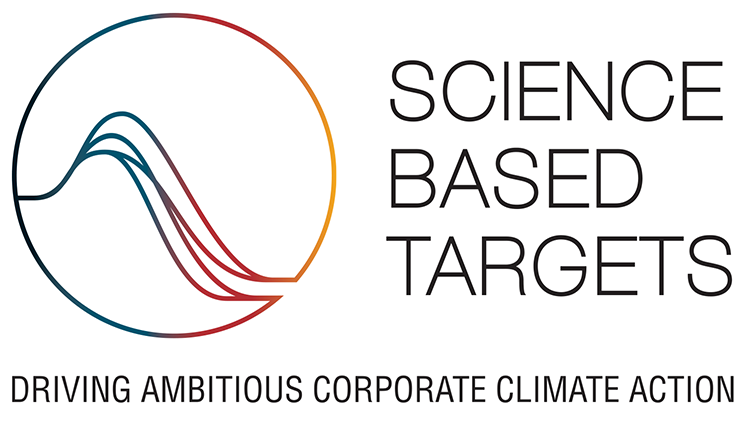Science Based Targets
The Science Based Targets initiative
Reducing our environmental impact is one of the main actions that companies can take to reduce global warming, curb climate change and contribute to the decarbonisation of the economy and society. The European Union committed in 2021 to achieve carbon neutrality by 2050 across the EU and the Science Based Targets initiative is key to this process.
Science Based Targets (SBTs) are a set of defined targets to establish a clear pathway for reducing greenhouse gas emissions.
For an emissions reduction target to be considered aligned with science, it must be aligned with the scale of reductions needed to keep global warming below 2°C above pre-industrial levels.
The initiative that defines and validates these science-based targets is the
Science Based Targets Initiative  , a partnership of the Carbon Disclosure Project (CDP), the UN Global Compact, the World Resources Institute (WRI) and the World Wide Fund for Nature (WWF).
, a partnership of the Carbon Disclosure Project (CDP), the UN Global Compact, the World Resources Institute (WRI) and the World Wide Fund for Nature (WWF).
This initiative identifies and promotes innovative approaches to setting ambitious and meaningful corporate greenhouse gas reduction targets.
Iberdrola's Net Zero commitment, validated by Science Based Targets initiative
Iberdrola is committed to achieving zero net greenhouse gas emissions across the entire value chain by 2039 from the 2020 base year. This target includes short- and long-term emission reduction milestones in line with a 1.5°C trajectory.
In the short term, the company commits to reduce absolute Scope 1, 2 and 3 greenhouse gas (GHG) emissions by 65% by 2030 from the base year 2020.
In the long term, Iberdrola has committed to reduce Scope 1, 2 and 3 emissions by 90 % by 2039 from a base year of 2020.
These commitments are broken down into different quantifiable sub-objectives.
Net zero target
Iberdrola is committed to achieving zero net greenhouse gas emissions across the value chain by 2039 from a 2020 base year.
Near-term objectives
Iberdrola is committed to reducing absolute Scope 1, 2 and 3 GHG emissions by 65% in 2030 compared to the base year 2020. Within this target:
- Iberdrola commits to reduce the intensity of Scope 1 and 2 GHG emissions from power generation by 83% per kWh by 2030 from a 2020 base year.
- Iberdrola also commits to reduce the GHG emissions intensity of Scope 1 and 3 activities related to fuels and energy, covering all electricity sold by 85% per kWh in the same timeframe.
- Iberdrola is also committed to reducing absolute Scope 3 GHG emissions from the use of products sold by 42% in the same timeframe.
- Iberdrola is also committed to reducing the remaining absolute Scope 3 GHG emissions by 46% in the same timeframe.
Long-term objectives
Iberdrola commits to reduce Scope 1, 2 and 3 emissions by 90% by 2039 compared to the base year 2020. Within this target:
- Iberdrola commits to reduce the intensity of Scope 1 and 2 GHG emissions from power generation by 84% per kWh by 2039 from a 2020 base year.
- Iberdrola also commits to reduce the GHG emissions intensity of Scope 1 and 3 activities related to fuel and energy by covering all electricity sold by 95% per kWh in the same timeframe.
- Iberdrola also commits to reduce absolute Scope 3 GHG emissions from the use of the products sold by 90% in the same timeframe.
- Iberdrola also commits to reduce the remaining absolute Scope 3 GHG emissions by 90% in the same timeframe.

Carbon footprint
What is the carbon footprint and why will reducing it help to combat climate change?

Carbon markets
How are emission allowances and carbon credits markets regulated?

Science of climate change
The science of climate change: What do we know about the greatest challenge that humanity is facing?
What are Scope 1, 2 and 3 emissions?
The concept of carbon footprint refers to the total amount of greenhouse gases emitted directly or indirectly into the atmosphere, whether by an individual, an organisation, an event or a product.
These emissions are produced either through the development of an organisation's activity or an event; or by taking into account the GHGs emitted during the entire life cycle of a product, from its manufacture to its end.
How is the carbon footprint measured? The final result is obtained by multiplying the consumption figure by the corresponding emission factor depending on the type of fuel or gas used in the activity carried out.
Emissions associated with an organisation's activity are further classified into direct emissions and indirect emissions. Direct emissions are those from sources owned or controlled by the organisation. They are the emissions released at the place where the activity is carried out.
Indirect emissions, on the other hand, are a consequence of the organisation's activities, but occur at sources owned or controlled by a third party, such as a supplier.
Knowing all this, when we refer to the carbon footprint of an organisation and the emission sources that are analysed in its calculation, we have to talk about the Scope. There are three scopes, 1, 2 and 3, and each of them defines the type of emissions detected and, on the other hand, indicates the path to follow in order to apply the appropriate measures.
- Scope 1 refers to direct GHG emissions, i.e., emissions arising from combustion in boilers, vehicles and other sources owned by the entity concerned. It also includes fugitive emissions, i.e., emissions from some form of gas leakage.
- Scope 2 refers to indirect GHG emissions associated with electricity generation, in this case electricity purchased and consumed by an organisation.
- Scope 3 refers to other indirect emissions that occur in a company's value chain, e.g., those related to the extraction and production of purchased materials; those generated during the use of sold products; with business travel by external means (commercial aircraft, etc.); those related to the transport of raw materials, fuels or products that are carried out by third parties, and so on.
Scope 1 and 2 emissions can be easily measured "inside" the company, and can be controlled by taking decarbonisation measures. On the other hand, Scope 3 emissions are more challenging to reduce as the company must act along its entire value chain, from suppliers and products and services used to its customers and the impact of the products and services it sells, and drive change without having full control over these emissions.
At Iberdrola, we maintain a Greenhouse Gas Inventory to facilitate the calculation of the carbon footprint, based on international standards such as the GHG (Protocol Corporate Accounting and Reporting Standard) and the ISO 14064-1:2018 standard. In addition, we have a complete decarbonisation strategy that details both the objectives set and the levers to be used.





